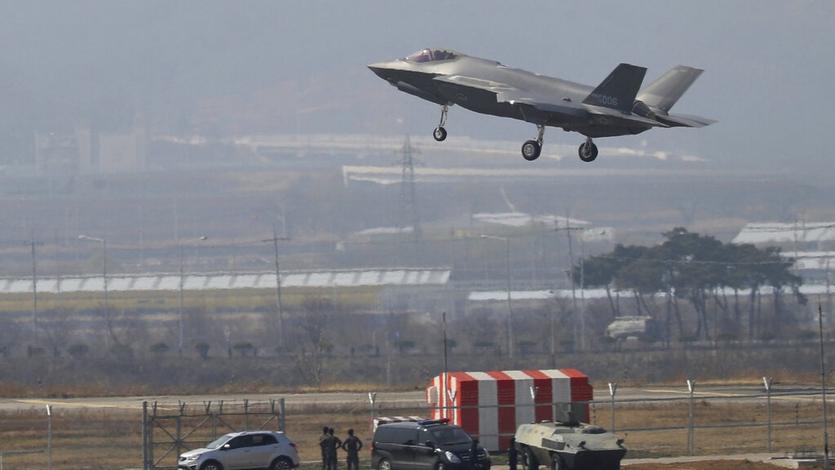 In this March 29, 2019, photo, a US F-35A fighter jet prepares to land at Chungju Air Base in Chungju, the Republic of Korea. (KANG JONG-MIN / NEWSIS VIA AP)
In this March 29, 2019, photo, a US F-35A fighter jet prepares to land at Chungju Air Base in Chungju, the Republic of Korea. (KANG JONG-MIN / NEWSIS VIA AP)
A new arms race has emerged in many parts of the world, triggered largely by the Russia-Ukraine conflict.
In Washington, the US State Department announced on April 1 that it has approved a potential sale of up to eight F-16 fighter jets and related equipment to Bulgaria in a deal valued at $1.67 billion.
The principal contractor will be Lockheed Martin, according to the Pentagon. Reuters reported the aircraft would not be ready for delivery for three to four years.
Lockheed Martin is also Canada's preferred bidder to supply 88 new fighter jets, Canadian Procurement Minister Filomena Tassi said on March 28.
The European Union has approved its Strategic Compass document, which calls for a new 5,000-strong rapid reaction force and "further incentives for member states to engage in collaborative capability development"
"This announcement marks another important milestone in Canada's competitive process to purchase modern fighter jets for the Royal Canadian Air Force," she said.
Canada has been trying unsuccessfully for more than a decade to replace its aging F-18 fighters. In 2010, the former Conservative administration said that it would buy 65 F-35 jets but later scrapped the decision, triggering years of delays and reviews, according to Reuters.
Ottawa hopes to award the contract this year and said it could be worth up to $15.1 billion. It hopes to take the first deliveries in 2025.
The United Kingdom will work with the United States and Australia on developing nuclear-capable hypersonic weapons, after Russia used the Kinzhal hypersonic missiles in airstrikes last month in its special military operation in Ukraine, The Guardian newspaper reported from London.
The US tested its hypersonic missile last month, and it is already collaborating on the weapon with Australia. The two countries are affiliated with the UK through the AUKUS security pact.
READ MORE: US, Britain, Australia to develop hypersonic missiles
Rising defense spending
Some European nations are also set to boost their air defense capabilities.
Estonia has approved a $523 million defense spending increase, most of which is for short-to midrange air defense systems, which it aims to acquire no later than 2025, according to Defense News in the US.
The Finnish Air Force will replace its 57 F-18 Hornet front-line fighters purchased from McDonnell Douglas in 1992 with the F-35 fighter jets. It plans to phase out all existing Hornets by 2030, and expects to take delivery of the first F-35 jets in 2026, according to Defense News.
European governments have said they would make billions of euros available in additional defense spending after Russia began its special military operation in Ukraine.
Germany has announced an additional $110 billion in arms spending over five to 10 years, and the Italian Parliament backed a vote to increase its defense spending to 2 percent of its gross domestic product, Defense News reported.
The European Union has approved its Strategic Compass document, which calls for a new 5,000-strong rapid reaction force and "further incentives for member states to engage in collaborative capability development".
In an interview with AFP, Siemon Wezeman, who has co-authored the Stockholm International Peace Research Institute's annual report for over 30 years, referred to Europe as "the new hot spot".
Europe's share of the global arms trade has already risen from 10 to 13 percent in the past five years, and it will increase "substantially", Wezeman said.
In China, Foreign Ministry spokesman Zhao Lijian said at a news conference on Wednesday that AUKUS-exploiting the Ukraine crisis and using the pretext of maintaining security and stability in the Asia-Pacific-declared in a high-profile manner that the US and the UK will provide nuclear-powered submarines to Australia and that the three countries will cooperate on advanced military technologies such as hypersonic weapons.
This development not only increases the risk of nuclear proliferation, but also intensifies the arms race and undermines peace and stability in the Asia-Pacific, he said.
Zhao said that AUKUS is an Anglo-Saxon clique, where the old thinking of Cold War mentality and bloc politics persists and the old trick of provoking military confrontation and adding fuel to the fire lingers. Its ultimate goal is to build a NATO replica in the Asia-Pacific to serve the US hegemony and self-interests.
In an article published on March 9 by The Conversation, Peter Bloom, a professor at the University of Essex, called for exploring ways of limiting the power and influence of the defense industry in the aftermath of the Ukraine crisis.
"This could include international agreements to limit the sale of specific weapons, multilateral support for countries that commit to reducing their defense industry, and sanctioning arms companies that appear to be lobbying for increased military spending," he wrote.
Long-lasting peace is impossible without eliminating as much as possible the manufacturing and sale of weapons as a lucrative industry, Bloom said.
Zhang Hong, a research fellow of Russian, East European and Central Asian Studies at the Chinese Academy of Social Sciences, said the US and NATO raise and play up anxieties about security. Their true aims are encouraging some Asia-Pacific countries to accept or ask for "more reliable security protection" from the US. As a result, more-lethal weapons could be deployed in these countries, Zhang said.


